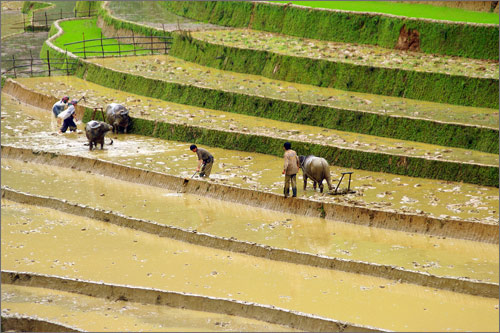You will be picked up at 20:00 from your hotel and transferred to the train station. Here, you take a night train to Lao Cai. The night train leaves at 21:10. Overnight stay on train in a 4-berth soft sleeper cabin.
The train arrives at Lao Cai train station early in the morning, at around 06:00. Pick-up and transport by shared bus to Sapa (35km – about 1 hour drive). In the morning, there will be some spare time to enjoy the fantastic view of the Sapa valley and explore the local market. In the afternoon the guide will provide with more information about the tour. After this we’ll visit the Cat Cat village, where the Black H’mong people live. Overnight stay at o hotel in Sapa.
After breakfast, leaving the hotel and trekking to Lao Chai village to visit the Black H’mong people. From Lao Chai you’ll continue to Ta Van village to visit the Zay people. Dining and sleeping in a local homestay in the Ta Van village.
Trekking distance: 15km
Walking tour to Giang Ta Chai village to visit Red Dao people. The women of Red Dao have a very colorful red embroideries, coins on their clothing, and on their head they wear a red scarf. Some of the women have shaved off their eyebrows because a hairless face is considered, by the the Red Dao people, to be very beautiful. We then make our way to the waterfall in Giang Ta Chai. In the afternoon we’ll make our way to Ban Ho, to visit the Tay people. If we arrive early there will be some spare time to go for a swim in the nearby river.
Trekking distance: 15km
After breakfast, trekking up to Su Pan hill (3km). Pick-up and transport back to Sapa. In the afternoon, there will be some spare time to experience the colorful Sapa market. Overnight stay at a hotel in Sapa.
In the morning driving in a car to Lai Chau. On the first part of the trip we will pass the beautiful Silver Waterfall Thac Bac and Tram Ton Pass (1900m). Later there will be a chance to visit Lao, Lu, Thai, Mang and Black Dao villages. Arrival in the afternoon to Lai Chau – one of the hottest places in Vietnam during the summer months. Overnight stay at a hotel in Lai Chau.
Starting the day by driving to Dien Bien Phu. While driving, one can enjoy the spectacular view of the forested hills. Making several stops on the way to visit some of the minority villages (Kho Mu, Thai and H’mong). Arrival in the noon at Dien Bien Phu in the flat Muong Thanh Valley. Dien Bien Phu was the place, where the last battle between the forces of Ho Chi Minh’s Viet Minh army and the French(1954). In the afternoon visiting the Museum in Dien Bien Phu, which gives a better understanding of the Vietnamese history. Overnight stay at a hotel in Dien Bien Phu.
Leaving Dien Bien Phu and driving to Son La. The drive is beautiful, with high mountains, limestone rocks, gorges, rice fields and small villages. Before arriving in Son La the bus makes a stop in a small village, where there will be a chance to visit the Thai people. Overnight stay in Son La.
Leaving the hotel at 08:00 in the morning for a short trek and visiting another Thai village. Arrival late in the afternoon at Lat village in Mai chau, where we’ll spend the night at local homestay.
Leaving Mai Chau at 08:00 in the morning and heading for Hanoi. On the way to Hanoi we’ll visit the Hoa Binh Hydro-Electric Power. Later in the afternoon we’ll arrive in Hanoi, where the tour ends.
|
Class
|
Size of group
|
Booking
|
|||||
|
1 pax
|
2 pax
|
3 pax
|
4+ pax
|
Children
|
Single Room
|
||
|
Standard
|
1,200
|
688
|
575
|
529
|
344
|
0
|
|






.jpeg)




























